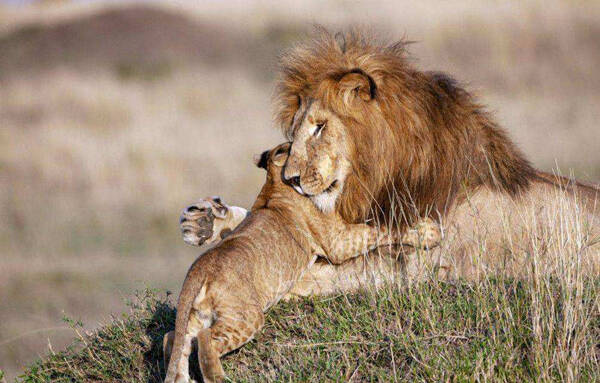Panthera leo hollisteri
IUCN
LCBasic Information
Scientific classification
- name:Panthera leo hollisteri
- Scientific Name:Panthera leo hollisteri
- Outline:Carnivora
- Family:Schizopoda Felidae Panthera
Vital signs
- length:About 1.8 meters
- Weight:180-230kg
- lifetime:20-25 years
Feature
The hair is short and hard, and the body color is light gray, yellow or brown.
Distribution and Habitat
Distributed in Sotik, western Kenya, northwest of Lake Victoria.
Appearance
The Kenyan lion is a subspecies of lion and is now one of the Nubian lion populations. Male Kenyan lions weigh 180 to 230 kilograms, and are generally up to 1.8 meters long, with a tail length of up to 0.9 meters and a total length of up to 2.7 meters. Females are smaller, generally two-thirds the size of male lions. The hair is short and hard, and the body color is light gray, yellow or brown. Male lions have long manes that extend to the shoulders and chest.
Lions have short hair and their body color is light gray, yellow or brown. Male lions have long manes that extend to the shoulders and chest. Male lions with longer and darker manes often attract more attention from lionesses.
Details
Kenyan lion (scientific name: Panthera leo hollisteri) is a subspecies of lion and is now one of the Nubian lion populations.

Lions usually live in groups, with a lion group of about 8 to 30 members, with an average of 17. It often includes several generations of lionesses, at least one adult male lion and some growing lion cubs. Lionesses form the core of the lion group and rarely leave the place where they were born. Lions contain at least 2 adult male lions, but there is always only one leader. Adult male lions often do not stay with the lion group. They have to wander around the territory all year round to defend the entire territory. Generally, they can be the leader of the lion group for a few months to a few years, depending on whether they have enough ability to defeat foreign male lions.
A lion group usually consists of 4-12 related lionesses, their children and 2 to 4 male lions. These male lions are often also related, such as brothers. The size of the lion group depends on the habitat conditions and the amount of prey. Lion groups in East Africa tend to be larger because there is plenty of food there.
Lions will try to avoid encounters with other lions, and male lions mark their territories by roaring and smelling urine. They usually roar before hunting in the evening and before waking up at dawn to start activities. The territories of lions vary in size, and the boundaries are divided by excrement. Sometimes the territories of adjacent lions overlap. The territories of African lions often intersect with those of spotted hyenas, leopards and other beasts, and competition is inevitable. Leopards, hyenas and other animals are in a suppressed position in the territory, and spotted hyenas with a numerical advantage sometimes challenge lone female lions and kill them.
In lion groups, female lions are the main hunters. Lionesses often hunt in groups, with members of the pride spreading out to form a fan-shaped circle around a group of prey, encircling the prey in the middle, and then approaching from all directions. Lions prey on a wide range of prey, often killing African buffalo, gazelles, and giraffes, but they prefer to hunt medium-sized to large ungulates, such as zebras, impalas, and other types of antelope.
The gestation period of a lioness is generally 100-119 days, and there may be 1-6 cubs each time (usually 2-4). When the cubs are just born, they have ochre spots on their bodies, especially on their abdomens and legs. The cubs begin to try to eat meat when they are four weeks old, usually semi-digested meat that their mothers vomit back to them. When they grow to 6 or 7 months old, they are basically weaned, and the spots on their bodies gradually disappear. The cubs usually grow up with their mothers until they are about 2 years old, at which time the male sub-adults face the severe problem of independence. To reach sexual maturity, females have to grow to 2-3 years old, and males have to be 5-6 years old.
The lion's biggest natural enemy is humans. Human hunting and habitat loss have put all African lion subspecies at risk of survival. African lions also face the trouble of disease. Infectious diseases that break out on the grasslands can kill tens of thousands of animals in a short period of time, such as tuberculosis and feline AIDS (FIV). According to the Kenya Broadcasting Corporation on the 18th, there were 2,749 lions in Kenya in 2002, but only about 2,000 are left. If no protective measures are taken, the lions in Kenya may disappear in 20 years if this trend continues. The Kenya Wildlife Service said, "Every effort must be made to maintain the current number of lions and increase them." Kenya Wildlife Service said that natural disasters have occurred frequently in Kenya in the past 10 years, especially the recent drought, which has posed a great threat to the survival of lions. At the same time, due to the severe drought, some herders drove livestock into the nature reserve to find food. Lions in the reserve frequently attacked livestock and even herders. Herders shot and poisoned lions.
Listed in the 2008 Red List of Endangered Species of the World Conservation Union (IUCN) ver 3.1-Vulnerable (VU).
Protect wild animals and eliminate game.
Maintaining ecological balance is everyone's responsibility!








